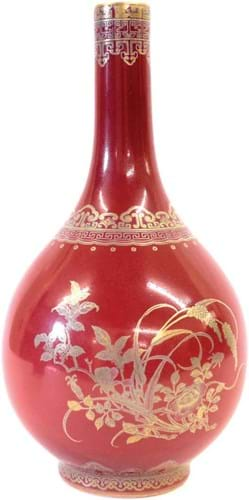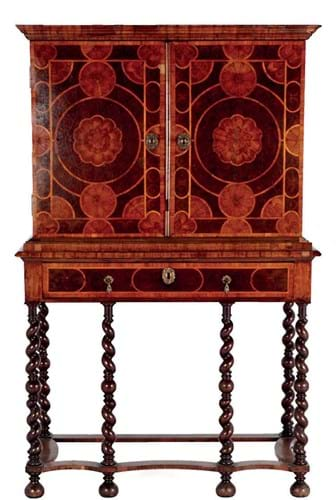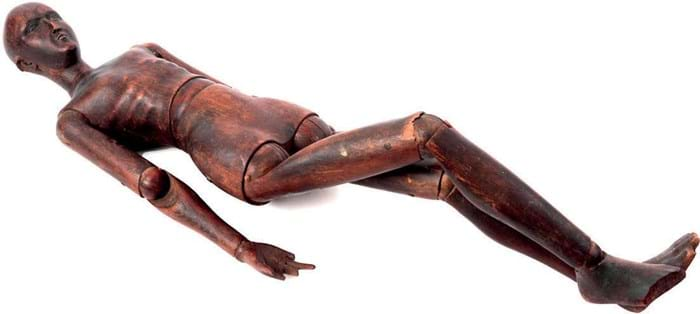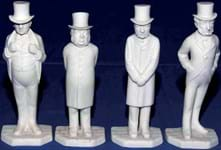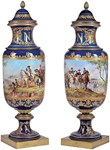Ninety per cent of the 830 lots got away to total of £588,860.
Making the biggest contribution was the familiar phenomenon of the Chinese ‘surprise’.
Selling to the UK trade at £55,000, way above the £300-400 estimate, was a 13in (33cm) tall bottle vase decorated with stylised foliage and calligraphy in gilt on a coral red ground.
This type of decoration reached its popular height in the 18th and 19th centuries, with this vase carrying a Qianlong (1735-96) reign mark. The auction house said it was ‘not of the period’ but several bidders plainly thought differently.
Fine dining table
Leading the furniture section was an early 20th century Jupe-style radially extending dining table by Maple & Co.
With eight extra wedge-shaped leaves giving an 8ft (2.43m) diameter top, the base was in the Georgian style with stop-fluted legs featuring ball and claw feet. The table doubled the lower estimate, selling to the London trade at £14,000.
Another purchase for the UK trade, within estimate at £6500, was a 5ft 6in (1.68m) tall olivewood, kingwood and oyster veneered cabinet on stand from the William and Mary period, c.1695. The geometric pattern cupboard doors opened to an arrangement of 10 drawers around a central cupboard door.
Perhaps the most eye-catching lot among the furniture was the pair of 2ft 7in (80cm) carved oak figures of snarling lions. One was carved Anno, the other 1632 and the weathered condition was testament to their years. Condition influenced the £400-600 estimate but did not deter bidders – the lions went to a private buyer at £8000.
Combining decorative appeal with craftsmanship and patination, a late 19th century French artist’s walnut jointed lay figure proved similarly popular. The 2ft 10in (85cm) long figure had desirable signs of age and use – chips throughout, losses to finger tips, scuffs and scratches – and against a £500-700 estimate it went to the UK trade at £4500.
Six 17th century lantern clocks from the private collection of North Yorkshire specialist Brian Loomes were a major attraction.
An unsigned example, whose maker had eluded even the noted researcher and writer Loomes, proved the best-seller.
Made in the so-called Third Period, c.1680, its adaptations referenced the fast-changing world of late 17th century technology. Soon after the clock was made it had been converted from a balance wheel to side-fitted pendulum with a half-hour strike added (possibly by a French clockmaker). Now missing its alarm work and lacking its side doors, it was estimated at £2500-3000 and sold to a private enthusiast at £4800.
British ceramics were topped by a pair of 10in (25cm) long models of recumbent, lettuce-eating black and white rabbits. Among the most desirable of all Staffordshire animal models, these overcame restoration to the ears and some retouching to sell against hopes £600-800 to the UK trade at £3800.
The Sheffield Assay Office register of maker’s marks (now called sponsor’s marks) go back to 1773. Leading the silver was a handsome 4¾in (12cm) stirrup-cup modelled as a snarling fox head by Henry Tudor and Thomas Leader. With marks for Sheffield 1777, it took a mid-estimate £5500 from a London collector.
Another collector took a silver-gilt-mounted hardstone inkwell modelled as a horse’s hoof with marks for Paul Storr, London, 1832 at a mid-estimate £4000.
Going way above hopes was a silver and horn-mounted bamboo walking stick doubling as horse and hound measuring cane.
Stamped for Swaine & Adeney, 185 Piccadilly, London, it was also engraved to the silver collar with a presentation inscription dated Xmas 1905. Pitched at £300-400, it sold to a collector at £2300.
Best of two opulent brass-bound paint boxes by top names was a late 19th century, 20in (51cm) wide mahogany example by Winsor & Newton with two frieze drawers containing fitted compartments with a variety of artist’s related items. It was pitched at £100-150 but sold at £2400.


